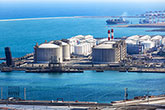CEZ has acquired capacity at the German Stade terminal
Published by Oliver Kleinschmidt,
Editorial Assistant
Tanks and Terminals,
The Czech Republic has taken another crucial step towards ensuring sufficient gas supplies for the future and replacing supplies from Russia.
In cooperation with the government, CEZ Group has contracted long-term annual capacity of 2 billion m3 at one of the onshore LNG terminals in Germany. This represents an investment in the further development of the Czech energy sector and strengthens the energy security of the Czech Republic. The Stade terminal will be located near Hamburg at the mouth of the Elbe River on the North Sea and will be commissioned by its operator, Hanseatic Energy Hub, in mid-2027.
“We promised to our citizens that we would strengthen the energy security of our country. We promised this as a government, and I defined it as one of the fundamental prerequisites for restarting Czechia. We have already taken several concrete steps, now we are adding another important piece of the mosaic. After acquiring the capacity of the LNG terminal in the Netherlands, we managed to secure capacity in the German terminal Stade as well. Together with the purchase of gas storage tanks and pipelines, we are fundamentally increasing the possibilities of transportation and storage of natural gas from reliable suppliers, and at the same time we are fulfilling the policy statement of the government and my personal vision of Restart Czechia,” said Czech Prime Minister Petr Fiala.
CEZ has secured capacity of two billion m3 of gas per year for the Czech Republic at the terminal, more than a quarter of the country’s annual gas consumption, which dropped from 9.4 billion m3 in 2021 to 7.5 billion m3 in 2022. This year, around 700 million m3 (around 10%) were saved compared to last year. This reduction in gas consumption has significantly contributed to the Czech Republic being able to do without gas imports from Russia. However, natural gas will continue to play an important role in the Czech energy sector in the years to come. It will help replace coal in heating and help maintain grid stability in electricity production.
From 2027, the terminal at Stade will enable the importing and regasification of liquid natural gas, while later it will be possible to convert the terminal to import and process climate-neutral ammonia, from which green hydrogen can be produced. The capacity at the terminal has been leased for 15 years, with an option to extend this to 25 years in connection with the future use of green hydrogen. At the same time, the Ministry of Industry and Trade supported the transaction by concluding a hedging agreement with CEZ Group similar to the one for the Eemshaven terminal.
“I am very pleased that these long negotiations have been completed. I would like to thank the representatives of both the Czech and German governments who supported the negotiations, as well as our partners from Hanseatic Energy Hub, which is building the terminal. Onshore terminals will gradually replace the temporary floating ones, so from the outset we sought to acquire long-term capacity in one of them. Until recently, we had not been in the LNG market at all, and over the last year and a half we have gained a lot of experience that we will now build on. We have leased capacity at the floating terminal in Eemshaven until the end of 2027, and thanks to Stade we will be able to smoothly continue supplying LNG after this date. Another advantage is that we will only have to cross one international border when transporting gas to the Czech Republic,” said CEZ CEO Daniel Beneš.
The advantages of onshore terminals over floating ones include higher capacity and faster LNG unloading and regasification. The Stade terminal will also include LNG storage tanks. Other lessees at the terminal are the German companies EnBW and SEFE. The terminal’s total capacity is 13.3 billion m3 of gas per year, of which 1.3 billion is intended for short-term contracts. The onshore terminal at Stade currently under construction will replace the floating one at the same location. The terminal is expected to be operational in 3Q27.
"Our goal is to build the best possible infrastructure at Stade to ensure the long-term energy security of supplies to Germany and Central Europe. Hence we looked for stable strategic partners to join us in this project. The terminal is based on a future flexible modular system for the transition to green energy in Europe. In 2027, we will launch an emissions-free terminal for LNG, bio-LNG and synthetic natural gas, while we are also preparing for the later expansion of the market in ammonia as a way to obtain green hydrogen," said Johann Killinger, Hanseatic Energy Hub managing director and shareholder.
Read the article online at: https://www.tanksterminals.com/terminals/23112023/ez-has-acquired-capacity-at-the-german-stade-terminal/
You might also like
Advario joins net zero alliance
Advario has joined the SOHAR Port & Freezone Net Zero Alliance in the Middle East.

